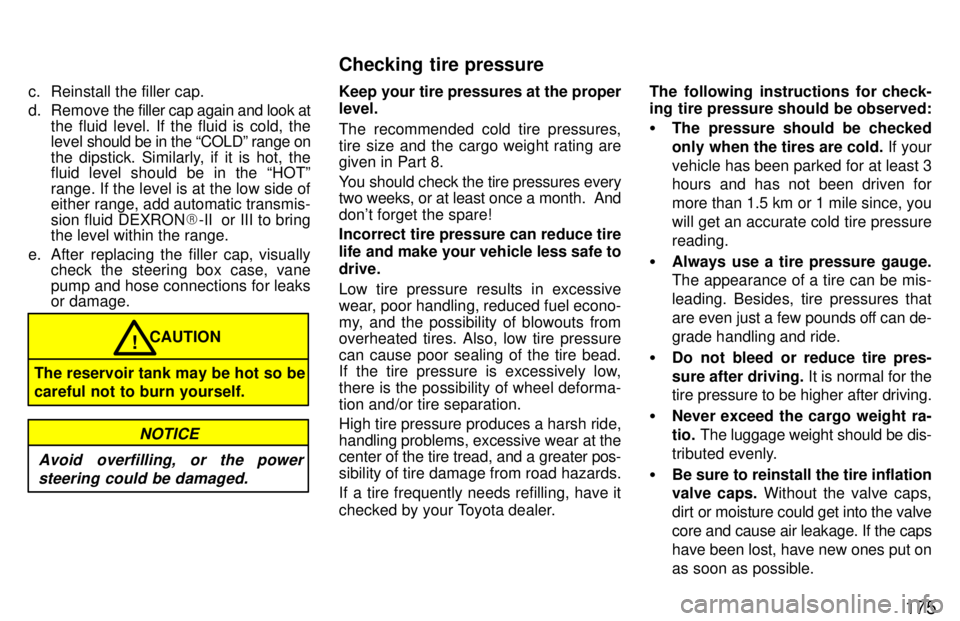power steering TOYOTA T100 1997 User Guide
[x] Cancel search | Manufacturer: TOYOTA, Model Year: 1997, Model line: T100, Model: TOYOTA T100 1997Pages: 212, PDF Size: 3.17 MB
Page 179 of 212

175
c. Reinstall the filler cap.
d. Remove
the filler cap again and look at
the fluid level. If the fluid is cold, the
level should be in the COLDº range on
the dipstick. Similarly, if it is hot, the
fluid level should be in the HOTº range. If the level is at the low side of either range, add automatic transmis-
sion fluid DEXRON �-II or III to bring
the level within the range.
e. After replacing the filler cap, visually check the steering box case, vane
pump and hose connections for leaks or damage.
CAUTION
The reservoir tank may be hot so be careful not to burn yourself.!
Avoid overfilling, or the power steering could be damaged.
NOTICE
Keep your tire pressures at the proper level.
The recommended cold tire pressures,
tire size and the cargo weight rating are
given in Part 8.
You should check the tire pressures every two weeks, or at least once a month. And
don't forget the spare!
Incorrect tire pressure can reduce tire
life and make your vehicle less safe todrive.
Low tire pressure results in excessive
wear, poor handling, reduced fuel econo-
my, and the possibility of blowouts from overheated tires. Also, low tire pressure
can cause poor sealing of the tire bead.
If the tire pressure is excessively low,
there is the possibility of wheel deforma-tion and/or tire separation.
High tire pressure produces a harsh ride,
handling problems, excessive wear at the center of the tire tread, and a greater pos-
sibility of tire damage from road hazards.
If a tire frequently needs refilling, have it
checked by your Toyota dealer. The following instructions for check-
ing tire pressure should be observed: �
The pressure should be checked
only when the tires are cold. If your
vehicle has been parked for at least 3 hours and has not been driven for more than 1.5 km or 1 mile since, you
will get an accurate cold tire pressurereading.
� Always use a tire pressure gauge.
The appearance of a tire can be mis-
leading. Besides, tire pressures that
are even just a few pounds off can de-
grade handling and ride.
� Do not bleed or reduce tire pres-sure after driving. It is normal for the
tire pressure to be higher after driving.
� Never exceed the cargo weight ra-tio. The luggage weight should be dis-
tributed evenly.
� Be sure to reinstall the tire inflation
valve caps. Without the valve caps,
dirt or moisture could get into the valve
core and cause air leakage. If the caps have been lost, have new ones put onas soon as possible.
Checking tire pressure
Page 201 of 212

197
Oil type:
Multipurpose gear oil API GL-4 or GL-5
Recommended oil viscosity: SAE 75W-90
AUTOMATIC TRANSMISSION Fluid capacity (drain and refill), L (qt., Imp. qt.):
Two-wheel drive models Up to 1.6 (1.7, 1.4)
Four-wheel drive models Up to 2.0 (2.1, 1.8)
Fluid type: Automatic transmission fluid D-II or DEXRON [
III (DEXRON [
II)
TRANSFER
Oil capacity, L (qt., lmp. qt.):
1.1 (1.2, 1.0)
Oil type:
Multipurpose gear oil API GL-4 or GL-5
Recommended oil viscosity: SAE 75W-90
DIFFERENTIAL
Oil capacity, L (qt., lmp. qt.): Two-wheel drive models
2.75 (2.9, 2.4)
Four-wheel drive models Front 1.9 (2.0, 1.7)
Rear 2.95 (3.1, 2.6) Oil type:
Hypoid gear oil API GL-5
Recommended oil viscosity: Front
SAE 75W-90
Rear Above -18 �C (0 �F)
SAE 90
Below -18 �C (0 �F)
SAE 80W or 80W-90
CHASSIS LUBRICATION Wheel bearings:
Lithium base wheel bearing grease, NLGI No. 2
Front drive shaft thrust bushings: Synthetic oil and lithium soap basechassis grease, NLGI No. 1
Propeller shafts: Spiders and slide yokes
Lithium base chassis grease,NLGI No. 2
Double cardan joint Molybdenum-disulfide lithium basechassis grease, NLGI No. 2
BRAKES Minimum pedal clearance when de- pressed with the pressure of 490 N (50
kgf, 110 lbf) with the engine running, mm (in.): Two-wheel drive models
1-ton models 78 (3.1)
1/2-ton models 73 (2.9)
Four-wheel drive models
1-ton models 70 (2.8)
1/2-ton models 73 (2.9)
Pedal freeplay, mm (in.):
3' 6 (0.12 '0.24)
Pad wear limit, mm (in.):
1.0 (0.04)
Lining wear limit, mm (in.):
1.0 (0.04)
Parking brake adjustment when pulled with the force of 196 N (20 kgf, 44 lbf): 11'17 clicks
Fluid type:
SAE J1703 or FMVSS No. 116 DOT 3
STEERING Wheel freeplay:
Less than 30 mm (1.2 in.)
Power steering fluid type:
Automatic transmission fluid DEXRON [
II or III